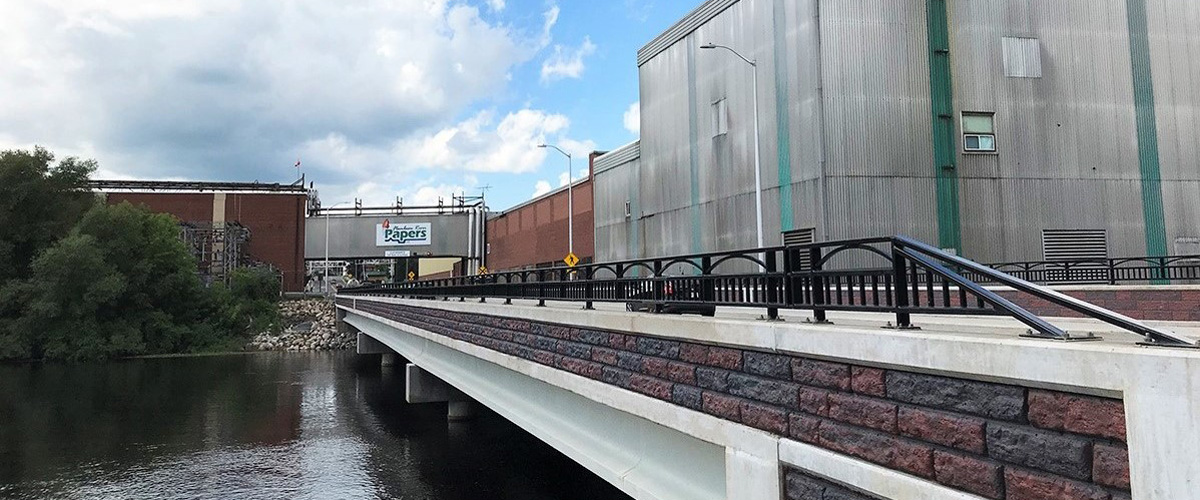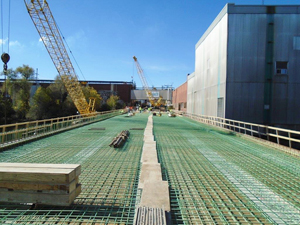Good Vibrations over Wisconsin’s Flambeau River

Written by Leah Rhodes, PE, MSA Professional Services
As you drive into the City of Park Falls, you are greeted with a sign reading, “Welcome to Park Falls – Bridging Nature with Industry.” This hybrid of attractions has fueled the success of this small north-central Wisconsin community since its incorporation in 1912, drawing anglers, paddlers and paper-mill entrepreneurs for as long as it can remember.
The main vehicular thoroughfare in the City, and the quickest route connecting residents to the hospital and other critical amenities, is via the bridge that crosses the Flambeau River on State Highway 182. The former bridge at this location—the only one crossing the waterway within City limits—was nearing 70 years old and in a state of serious deterioration. For a number of reasons, it needed attention – and quick.
The solution was a replacement bridge. More specifically, a new 282-foot, three-span, pre-stressed concrete girder bridge with a widened road width and 7-foot-wide sidewalk to accompany. However, a number of unique foundational and environmental challenges presented themselves: a shallow bedrock river with deep-water conditions, the extremely vibration-sensitive machinery of an adjacent local paper mill, a tightly restricted project footprint, and the need to protect the area’s most cherished recreational and natural resource–the Flambeau River.
A solid foundation
 Determining the best foundation and method of construction for a bridge project requires evaluation of location, site geotechnical and hydraulic analyses, determination of the scour potential and maximum scour depth–how much sediment could potentially erode from bridge abutments or piers, as caused by moving water.
Determining the best foundation and method of construction for a bridge project requires evaluation of location, site geotechnical and hydraulic analyses, determination of the scour potential and maximum scour depth–how much sediment could potentially erode from bridge abutments or piers, as caused by moving water.
Multi-column piers with drilled shaft foundations were selected as the best choice for the Park Falls STH 182 Bridge project, a category of foundation that transfers structural loads to a deeper stratum when a more competent soil or rock base is absent at the surface. Due to the shallow bedrock in the Flambeau River and relatively deep water conditions, more traditional piling and sheet pile cofferdam designs were not feasible because they would not adequately penetrate the substrate. Equally unworkable was a spread footing type of foundation, which caters to shallow foundations but also requires the same impenetrable sheet pile cofferdams.
Drilled shaft foundations, on the other hand, matched the site conditions perfectly. These are installed by drilling cylindrical boreholes to the requisite diameter and depth, placing reinforced steel into the column and then filling with cast-in-place concrete. Because drilled shafts do not require a hammer for installation—nor do they displace the adjacent soils—they have a minimalized vibrational impact on adjacent structures, a detail critical to the success of the Park Falls project.
Good vibrations
Park Falls is a community with a long history of industrial and riverfront milling operations. Flambeau River Papers inhabits property directly adjacent—within a few feet—to the bridge project. Mill management had great concern about the impact of the drilling component of the project because some machinery key to the paper manufacturing process, located immediately inside the mill building, was extremely sensitive to vibration. There was also concern about excess movement shaking loose dust or other foreign particles within the mill buildings, which could contaminate the integrity of the paper products themselves.
It was imperative that the drilling and construction methods protect mill operations.
Using drilled shafts provided the advantage of lower levels of vibrations created when drilling the holes, as compared to traditional piling or sheet piling in this type of substrate. As an additional safeguard, MSA employed special vibration monitoring equipment and a vibration specialist to take readings during the design stage to determine the baseline vibrations, then required the contractor to monitor vibrations during construction to gauge bands of frequency and alert crews if they exceeded the normal or preferred range of activity. These extra safeguards provided assurance to the adjacent paper mill management and resulted in no vibrational effects while allowing the new bridge to rest on a solid foundation.

Building Bridges
Whether replacing, rehabilitating or designing around the more particular intricacies of a bridge project, one thing is certain: bridges are community connectors. They keep communities moving and guarantee safe passage while doing so. The new bridge in Park Falls offers residents and visitors a durable, aesthetically-pleasing structure, one that represents the strength and growth of the community it inhabits. It will serve the region well for decades to come, metaphorically and literally bridging the gap between industry and nature, just as Park Falls intended.
About the Author:
![]() Leah Rhodes, PE, is the Bridge Team Leader at MSA Professional Services, Inc. Her expertise includes the design and analysis of bridges and other transportation structures. As a licensed professional engineer in Wisconsin, Iowa, and Minnesota, Leah helps communities solve their infrastructure challenges. MSA is a long-time ACEC WI member and a 100% employee-owned, full-service multidisciplinary consulting firm.
Leah Rhodes, PE, is the Bridge Team Leader at MSA Professional Services, Inc. Her expertise includes the design and analysis of bridges and other transportation structures. As a licensed professional engineer in Wisconsin, Iowa, and Minnesota, Leah helps communities solve their infrastructure challenges. MSA is a long-time ACEC WI member and a 100% employee-owned, full-service multidisciplinary consulting firm.
